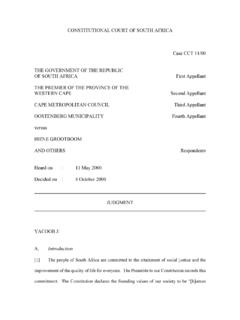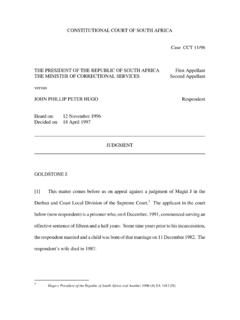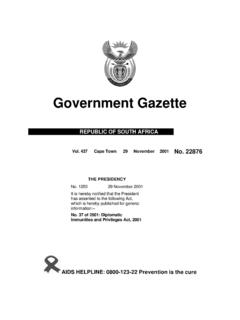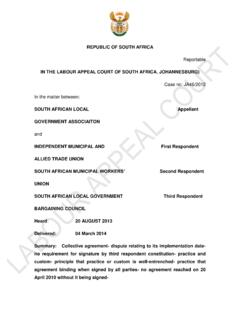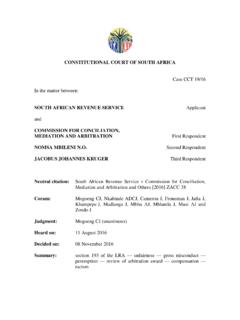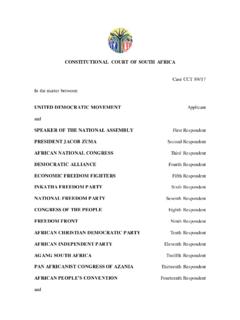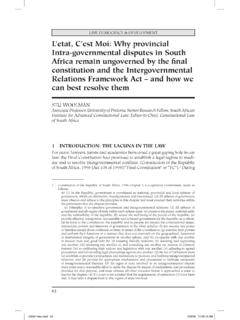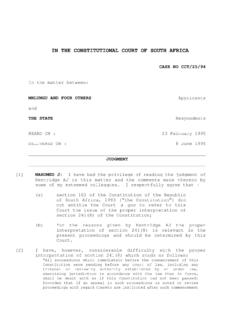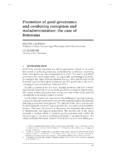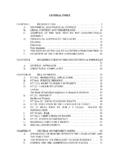Transcription of IN THE LABOUR COURT OF SOUTH AFRICA HELD …
1 IN THE LABOUR COURT OF SOUTH AFRICAHELD AT JOHANNESBURGCASE NO J2211/09In the matter between:MANOGRAN MUTHUSAMY Applicant andNEDBANK LIMITED Respondent _____JUDGMENT_____TIP issues in this case revolve around the question whether or not an employer can proceed with an inquiry into the conduct of an employee after the employment relationship has come to an end. The respondent ( Nedbank ) proposes to hold such inquiry, whereas the applicant seeks in these proceedings to obtain an order interdicting it from doing so and an order interdicting Nedbank from placing the applicant s name on the REDS database , which I describe below. Arising out of these basic differences between the parties is a preliminary question concerning this COURT s jurisdiction to deal with the matter at REDS is an acronym for Register of Employees Dishonesty System , this being a system established in the mid-1990s by what was then known as the Banking Council of SOUTH AFRICA , the predecessor of the current Banking Association of SOUTH AFRICA ( the Association ).
2 The Association represents all registered banks in SOUTH AFRICA , including domestic as well as international banks. Broadly stated, its role is to promote responsible, competitive and profitable banking and all its members subscribe to a Code of Banking Practice which inter alia aims to cultivate ethical practices within the industry. The RED system forms an important part of this program. In essence it comprises a centrally maintained database on which are recorded the names of all employees in the banking industry who have been dismissed for dishonesty-related offences. This database provides a screening resource for the use of participating banks in respect of prospective present, there are 26 such banks. Nedbank has been one of them since November 1999 and it has developed an integrity management system that incorporates the RED system as a recruitment and selection check.
3 Over the past decade or so, Nedbank has added 1348 names of dismissed employees to the database. In all, there are now over 9164 names on the register. The system is there to combat dishonesty in the banking environment and it is plain that by doing so it not only offers some protection to banks but also significantly buttresses the interest that the public has in trustworthy banking services. in the RED system takes the form of a written agreement, which includes implementation guidelines. Three principles are of particular importance in this case . The first is that an employee s name will be placed on the register only if he or she is dismissed for a dishonesty-related offence. The second is that a disciplinary hearing will still take place, in absentia if needs be, in the circumstance where the affected employee resigns or leaves before the hearing takes place.
4 If the RED criteria are met, that employee will be duly listed. The third is that contracts of employment should include consent to the RED process and that existing employees should be advised role of these principles in respect of this application must be considered in the context of the relevant facts, which may be summarised as follows. The applicant has been employed in the banking sector since 1989. In May 2007 he took up the position of senior manager credit risk with Nedbank. As from March 2009 queries were directed to him by internal investigators of the bank concerning his relationship with certain clients and on 3 July 2009 he was handed a letter of suspension in which it was alleged that he was involved in undisclosed conflicts of interest . The letter recorded that he remained subject to inter alia the bank s disciplinary procedure and that the suspension did not imply that his services had been terminated.
5 The applicant was dissatisfied with the manner in which he was being treated and he lodged a document headed Unfair LABOUR Practices on 6 August 2009. There is a difference between the parties as to whether this amounted to a formal grievance and whether or not there was any response to it, but those are not matters which I need to 24 August 2009 the applicant submitted a resignation notice in these terms: Please accept this email as my official notification of resignation with immediate effect from Nedbank. As you are aware, from the 24 April 2009 to date (4 months) there has been no finality with regard to an investigation matter. At this point I am forced to resign .. There was a response to this on the following day which stated: I wish to confirm and advise that we have accepted and noted your resignation.
6 I am seeking IR input on the impact of the current investigation relating to your resignation. Will keep you posted once this is known to me. A certificate of service was subsequently issued, noting the exit date to be 25 August 2009. The applicant s employment contract provided for a notice period of four weeks and he was initially paid his salary for such further period. That payment was however thereafter reversed and his last salary payment accordingly went up to the 25th of August. 3 September 2009 Nedbank conveyed the following to the applicant: I have had the opportunity to study your complaints and the report by 3 Group Forensic Services and have also had the benefit of Group IR s input.. I have decided that it is justified to proceed with disciplinary action at a formal disciplinary enquiry. We are in the process of arranging the hearing.
7 The proceedings should be finalised before the expiry of your notice period, which is calculated from the date of your notice of resignation. However, for your benefit I need to point out that even if you had left the bank s employ by the time the proceedings started, the bank would still have had to determine through a formal enquiry whether your name should be listed on the REDS database. The applicant reacted to this by asserting that his resignation had been with immediate effect and that Nedbank s reference to a notice period was therefore misplaced. I must add that the papers set out a pr cis of the result of the investigation, amounting to 15 charges. Other than to note that they appear to be quite grave, I express no view on whether they might be sustained upon a correspondence ensued, basically to the effect that, for its part, Nedbank would be proceeding with a disciplinary hearing whereas, for his part, the applicant declared that he would not attend it.
8 The present application has arisen because Nedbank has made it clear that it intends to proceed with the enquiry whether or not the applicant attends. In turn, the applicant seeks to interdict the enquiry from taking place even in his Issue of way of preface, I observe that the question of jurisdiction is certainly not moot. This follows from my prima facie view that the second leg of Nedbank s defence is sound, namely that the applicant has not demonstrated a clear right to interdictory relief. The establishment of an appropriate reference database is no stranger to SOUTH African law, which recognises that a variety of fiduciary and professional fields may properly incorporate regulatory mechanisms in the form of a database or in the form of a roll of practitioners in good standing, in order to promote 4suitable standards of ethics and competence.
9 See for instance Hawker v Life Offices Association of SOUTH AFRICA and another 1987 (3) SA 777 (C) which dealt with the operation of a similar database in the field of life assurance. Indeed, in the present case , the applicant does not mount an attack on the RED system per se but confines himself to the submission that his resignation places him beyond that system s reach. At its most elemental, the applicant says that he has resigned, that he is therefore no longer an employee, that he can hence not be dismissed, and that an essential REDS requirement can consequently not be addressed, being that employees can be entered on the register only if they have been dismissed for a dishonesty-related offence. Although I do not decide the point, I would remark that it might be thought a little startling if the underlying purpose of such database bearing as it does an important public interest ingredient could be stultified in a particular instance through no more than a resignation.
10 Ambit of the jurisdiction issue is narrow. It concerns only the question whether the LABOUR COURT can adjudicate the principal prayers moved by the applicant, namely the interdiction of the hearing and, in any event, the prohibition of the entry of his name on the REDS database. Whilst those questions may be described as narrow, they do not yield ready answers. In part, that is so because the positions of both parties appear to some extent to contain anomalies. I deal with these first anomaly presents itself in the applicant s case . On the one hand, the applicant is insistent that he ceased to be an employee on the date of his resignation and that the employment relationship between him and Nedbank correspondingly terminated on the same day. On the other hand, he has approached this COURT for relief and not the High COURT .
